AAC Assessment Corner with Vicki Clarke: Standardized Tests For AAC Users
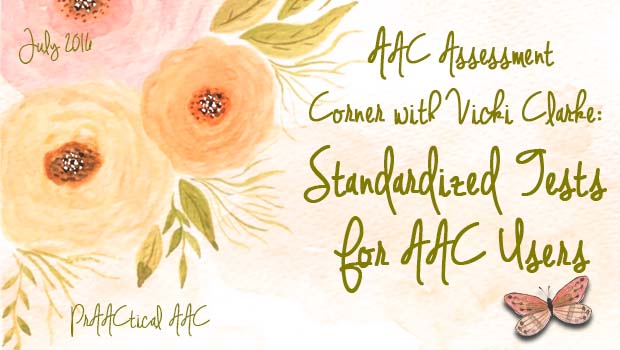
- Do you have a love-hate relationships with formal testing?
- Are you required to use normed tests with your minimally verbal clients?
- Looking for recommendations on which tests to use?
AAC specialist Vicki Clarke has you covered!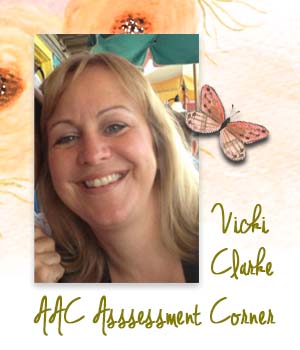
Like many of you, I’ve had mixed feeling when it comes to using normed assessment instruments with my AAC learners, particularly when we needed to modify the test materials or administration procedures in order for them to be able to participate and respond. If the client can’t point to pictures, give a verbal response, or sit through an entire test, we have no choice but to adapt how the test is administered. As we all know, when we adapt test materials (e.g., putting the test items on an eye gaze board) or procedures (e.g., partner-assisted scanning), we lose the ability to use the normative data. We can, though, compare our learners to themselves at a later point in time IF we administer the adapted test the same way every time. Even more importantly, these tests can give us insight into the skill set that our clients have.
In today’s post, Vicki shares her thoughts on using formal tests with people who use AAC, and discusses the use of popular instruments for assessing receptive and expressive language.
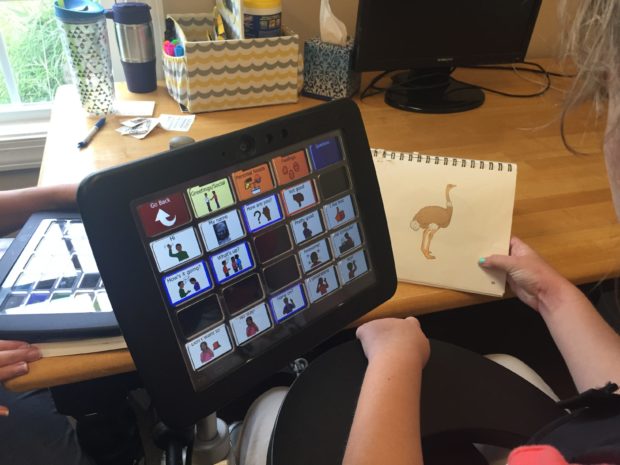
Standardized Tests For AAC Users: More Than “Less Than 55!”
Assessing the language skills of a person with significant expressive communication deficits is a challenging task. Professionals can’t report standardized test scores as reliable measures unless the evaluation instrument included nonverbal individuals in the standardization sampling. I don’t know of any standardized language assessments which use nonverbal individuals in their standardization process.
“Does this mean we should not use standardized tests with our nonverbal patients or students?”
I have to be honest: I have expressed a deep, abiding hatred of standardized test scores for many years. My objection was focused on the dismal scores, which are often reported without sufficient explanation. These scores limit partner expectations for my students and usher them into severe/profound placements. At their worst, these scores are used to justify delayed introduction to AAC. Let’s face it, a standard score of “less than 55” doesn’t help anyone.
However, standardized tests have value for us as we work to understand how our students understand and use language. They can give us ideas about an individual’s skills and areas we may need to target. Understanding how a person processes auditory language can help us develop appropriate expressive communication goals. For example, we wouldn’t want to target sentence construction for a student who doesn’t comprehend sufficient single word vocabulary.
I rarely use standardized tests to gain a standard score. I use them most often as criterion referenced measures to help me focus on the strengths and needs of the patient. Here are some of the assessment measure in my toolbox: (please note, I’m not reporting specific versions as these change fairly often. In addition, these tests fall into categories which may be addressed by other standardized tests. The ideas are the same, just substitute your favorite comprehensive test or vocabulary measure.)

Receptive One-Word Picture Vocabulary Test (ROWPVT) and Peabody Picture Vocabulary Test (PPVT)
These two tests give me a basic idea of a person’s understanding of single word vocabulary. I can get a standard score on these for all of my patients, although “less than 55” is still a common score. Of more value is my ability to use these tests to determine if teaching via verbal instruction has any value at all, or whether most of my instruction needs to include visual supports. For example, if my student’s single word vocabulary comprehension is less than 50 words, I probably need to supplement most of what I say with some sort of visual information. In clinical practice, however, many patients exhibit an ability to learn to express vocabulary at a higher level than their spoken language comprehension. Often we see students whose expression via symbols is higher than their auditory comprehension. For these students, I use their AAC systems to talk to them for every interaction. Aided language input is not simply a means to teach expressive language, but also a means to supplement understanding.
Expressive One-Word Picture Vocabulary Test (EOWPVT)
I use expressive vocabulary tests to satisfy our insurance/Medicaid requirement for a standardized assessment and to allow me to compare a patient’s expressive vocabulary skills using their speech vs. their augmented communication method. When we are justifying the purchase of a speech generating device, there is value in showing a person’s ability to express themselves with AAC despite motor speech impairment.
Single word expressive vocabulary tests also assist us in treatment planning. Even though we can’t report standard scores using augmented communication, we can use raw scores to compare an individual’s expressive vocabulary development over time. I use the EOWPVT to establish a baseline and then re-administer every few years to see the gains made in vocabulary expression. Often this shows gains in navigation and category comprehension. We can get an idea of which categories of vocabulary are important in our patient’s lives. In addition we can also have an idea of vocabulary that may be necessary but not yet developed.
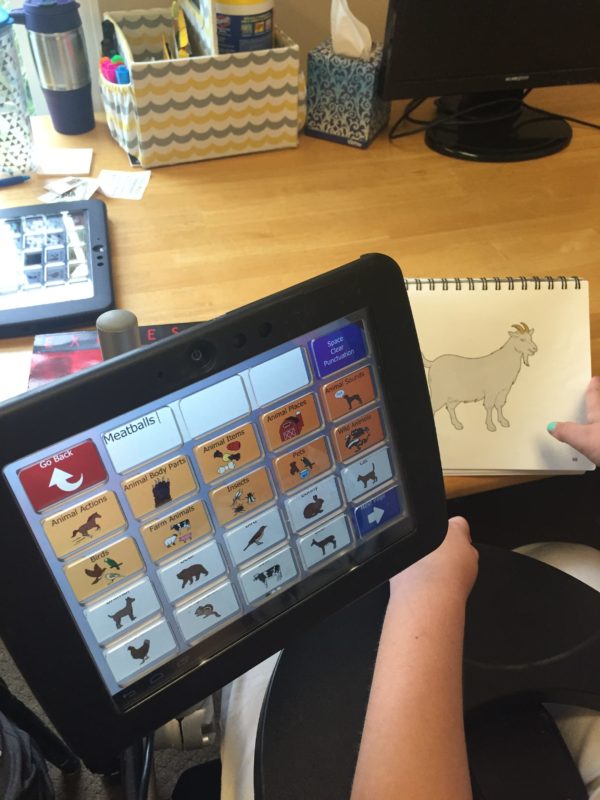
Preschool Language Scale and Test of Early Communication and Emerging Language (TECEL)
These are standardized tests that I use very often, but rarely for the purpose of reporting a standard score. The PLS and the TECEL are standardized on very young children (up to 7 years for the PLS and, up to 3 years for the TECEL). The both offer us language age equivalencies, but I strongly discourage the use of these scores when describing a nonverbal person. Frankly, no one wants to hear their 23 year old child is “functioning at 11 months.” It’s functionally inaccurate, because no person who has existed on this earth for 23 years functions like a 1 year old. Their performance in an isolated test situation may be similar but their life experiences paired with experience in understanding and using social and environmental cues usually leads to substantially more communicative competence than a young child.
These tests are, however, quite good for giving us ideas about a person’s isolated skill development in language and communication. They help us determine goals which may be of value to improve a person’s communicative competence. Does a student understand and ask questions? Does he pair more than one word/symbol to communicate? Does he understand and use descriptive terms? Are these skills significant to this particular individual?
Comprehensive Assessment of Spoken Language (CASL) and Comprehensive Evaluation of Language Fundamentals (CELF)
I find that I can rarely use these tests in their entirety for evaluating my students but, they do offer the ability to gain raw scores and standard measures for expressive language development on individual subtests. Generally speaking, if my student struggles with the single word vocabulary tests, these tests are too difficult to give me much additional information. If my student does well on single word measures, I can often get some additional information from these comprehensive assessments. They seem to work best for my students who have comparatively good receptive language skills but struggle with motor speech difficulties or expressive language impairment.
Once you begin to look at standardized tests as a means to gain information beyond a simple standard score, you can use these tests to inform your treatment methods, goal development and augmentative communication system selection. At a simplistic level, standardized testing allows you to meet the demands of insurance to show need for continued services. With a little more in-depth analysis of your student’s performance, the results have significant impact on our decisions and support of our AAC users.
Filed under: Featured Posts, PrAACtical Thinking
Tagged With: assessment, tests
This post was written by Carole Zangari

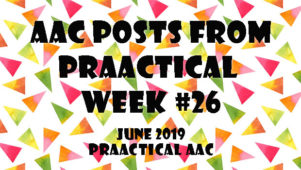
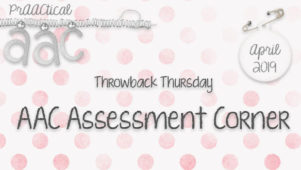
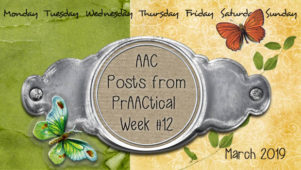
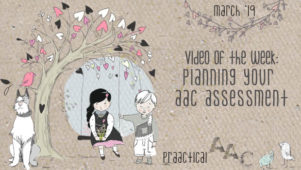
3 Comments
Hi Vickie
Thank you for this great article. I loved what you’ve said about reporting a standard score “no one wants to hear their 23 year old child is functioning at 11 months.”
I feel the same, and actualy when a team member does tht with parents – I feel embaressed! ,It also seems unfair to me – to measure abilities of a young child with special needs according to his age group. If he has totaly different starting point in his life, what is the point of comparing his abilities to a normal child? The only comparison should be to his own past achievements.
Also there is anather thought that passed my mind – Who mesures the ability of these children to survive countless hurtful and frightening ilnesses, exmintions, treatments, and worried parents faces, and still remain a happy child? I am sure that on this kind of test, they would get a much higher score then their normal peers. I suggest we do not forget that when we test a child and report his parents.
Vickie,
I am a Speech Pathologist who stumbled upon this post while searching for a list of standardized assessments I could use to gauge the abilities of a nonverbal student whose primary mode of communication is eye gaze. Your post was both thoughtful and informative.
I too hate the use of standardized and age-norm scores to talk about these students, and I find that for the most part, the parents of my students don’t care how their child measures up to the “average,” or where they fall on the Bell curve. The parents of my students are looking for good information about the strengths of their children. They already know about their weaknesses-doctors, behavior specialists and other teachers have told them those things a million times.
Bearing that thought in mind, do you know of any assessments that can be given to a student who uses eye gaze to communicate? I couldn’t think of any, but I need some attempt at a formal measure for eligibility…and I would so love a measure that might yield something worthwhile to tell the parents.
This is just what I needed. I am evaluating a student with an AAC device and wanted to see if any info was out there in regards to EOWPVT and comparing it to verbal speech output. Love your input and feel the same about standard scored and age-level reporting.